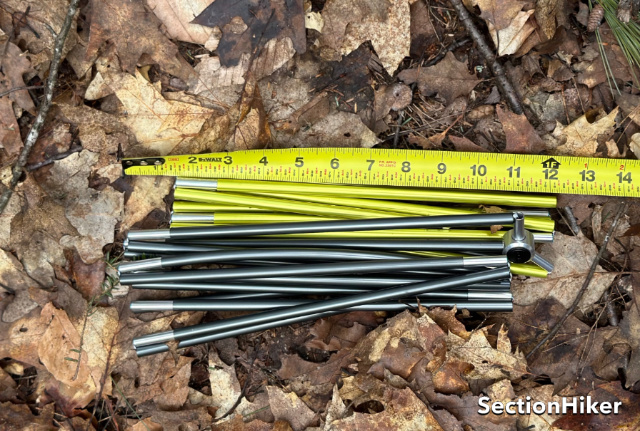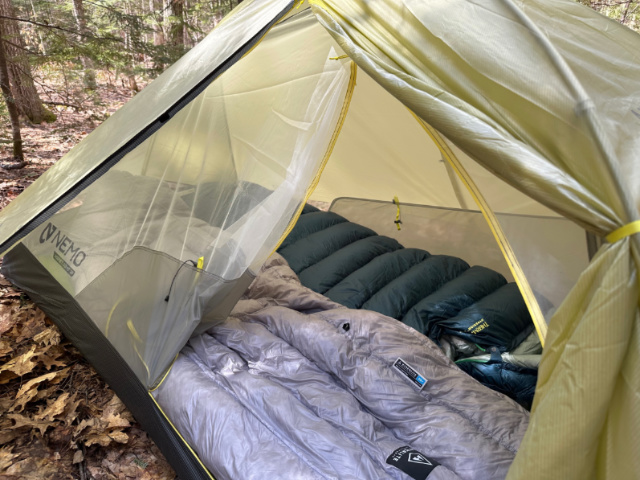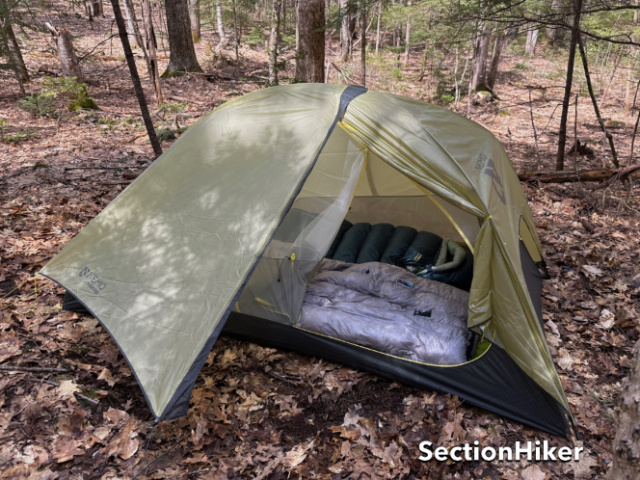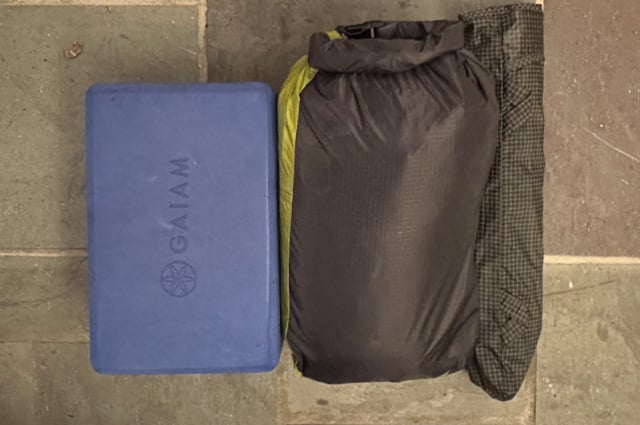The NEMO Hornet OSMO 2 is an ultralight double-wall semi-freestanding tent that is highly packable for bikepacking and backpacking, more so than a tent made with Dyneema DCF because it’s made with conventional fabrics that stuff more compactly. Weighing 34 oz, it has the two doors and two vestibules necessary for couples camping but is still lightweight enough that it can be used for solo camping if you only want to own one tent. It’s exceptionally well designed with numerous features that enhance its performance, with a stealthy color scheme that will ensure privacy if you like to camp off the beaten track.
RELATED: Ultralight Backpacking Double Wall Tent Guide
Specs at a glance
- Type: Double-wall
- Structural: Semi-Freestanding
- Minimum Trail Weight: 33 oz/936g
- Minimum Trail Weight Actual: 34 oz/964g
- Doors/Vestibules: 2
- Actual Inner Tent Dimensions: 49.5″ wide at the head end tapering down to 42″ at the foot end, 84″ long, with a peak height of 39″ Note: Most tent manufacturers measure their dimensions based on the rainfly; we use the inner tent instead since that is the best reflection of livability.
- Tentpoles: 1 with a maximum segment length of 12″
- Seam-Taped: Yes
- Minimum number of stakes to pitch: 6
- Rainfly: 0D OSMO Ripstop (1200 mm)
- Inner Tent: 0D OSMO™ Ripstop (1500 mm); 15D Nylon Ripstop/ No-See-Um Mesh
The NEMO Hornet OSMO 2 is a double wall, freestanding tent meaning it has an inner tent and an external rainfly and has one end (the foot end) that must be staked to the ground. Nothing special there, until you look closely at the design of this tent which is incredibly refined in terms of its livability, volume, ventilation, material, packability, and accessory choices. NEMO has always made well-designed tents, but the Hornet OSMO 2 really takes the cake if you’re looking for a lightweight tent that’s optimized for self-powered travel (backpacking or bikepacking.)
Inner Tent

The Hornet’s inner tent requires a single hubbed pole to set up. It has two doors, so you don’t have to climb over your partner to get in and out, if two are you are using the tent. The upper part of the tent is made with white and dark insect netting (the latter becomes transparent for stargazing from the inside) as well as solid panels closer to the floor to reduce the cooling effect of the wind and limit dust from blowing inside.

In order to increase interior space and livability, NEMO uses a volumizing pole clip on the ceiling they call a FlyBar, which serves to increase the angle of the walls creating more interior volume. It’s permanently attached to the inner tent so you can’t lose it. Other companies use a perpendicular cross pole attached to the main lengthwise pole to achieve the same effect, which can be easy to lose or creates more bulk, making their tents heavier and less compact.

The tent’s hubbed pole is special because the longest segment is a mere 12″ long making it easy to pack in a frame bag on a bicycle or horizontally in most backpacks. Some tent manufacturers, like Big Agnes, make separate tents for backpacking and bikepacking, so it’s nice that you can use the Hornet OSMO 2 for both (on alternating weekends).

The Hornet’s single pole slots into two jakes feet at the head end corners, which is just a special type of corner connector that can hold an inner tent and a rainfly with just one stake. That same pole fits into a connector positioned in the middle of the foot end. You still have to stake out the two front corners which attach to the inner tent in two places, creating enough corner height to form a bathtub floor without the need for extra hardware, like the struts that Tarptent uses. This keeps the Hornet very packable.

The interior of the inner tent is a bit snug on the horizontal dimension and you’ll probably want to use tapered mummy pads when camping as a couple instead of wide pads (49.5″ at the head end and 42″ at the foot end”). But the length of the inner tent provides additional storage space at the ends as well as headroom above (84″ long and 39″ high). For single-person use, the Hornet 2 is a complete palace.

Rainfly
The Hornet 2 Rainfly is made with a proprietary waterproof nylon/polyester blend that NEMO calls OSMO. Yes, it really does stretch less than conventional PU-coated or Silnylon rain flies when it gets wet. The rainfly fabric is quite thin and it doesn’t have a terribly high hydrostatic head (just 1200 mm), but man is it lightweight. It’s also really packable, as is this entire tent. It’s certainly adequate for use in more protected test sites, particularly in forested terrain. But I’d opt for a material that’s heavier, thicker, stronger, and more waterproof if you intend to camp out in the open above the timberline or unprotected tent sites that have the potential for high wind and heavy rainfall.

The doors have one-way zippers, not two-way, so you can’t leave them open at the top for more airflow. I didn’t find that that mattered that much since the airflow through the tent is so good. The zippers are covered with flaps, so that rain will stay off them and not pour all over you, kind of like a gutter if you have to open up the tent at night for a pee break. The edges of the tent are cut in catenary curves to save weight, provide a taut pitch, and for better aerodynamic resistance when it gets windy.

That said, you can only tie back half of the vestibule, which does limit views because you can’t open the side all the way for a picture window view which is often possible on a trekking pole tent. This also requires that you be somewhat deliberate in how you orient the tent with the closed side into the wind so that it doesn’t become a sail if the wind picks up at night. The storage space under the vestibule is also somewhat cramped if you have a larger backpack and don’t want to lean it against the inner tent to keep it upright at night. None of these are showstoppers, but they demonstrate some of the tradeoffs inherent in the dimensions and design.

Packability
With all the emphasis these days are backpacking gear weight, one dimension that’s frequently overlooked (unless you bikepack where storage space is so constrained) is the packability of a tent or shelter, and this is a place where the Hornet OSMO 2 really excels.

Personally, I find it a little mind-boggling just how small the Hornet OSMO 2 packs up. It’s literally just slightly larger than a yoga block. Not only are the pole segments short (see photo above), but the fabric folds up very compactly, and much more so than most Dyneema 2-person tents which are bulky in comparison. Better packability means that you can carry a smaller and lighter-weight backpack or carry more supplies so you can travel farther.
Recommendation
The NEMO Hornet OSMO 2 is an ultralight double-wall semi-freestanding tent that weighs just barely over 2 pounds. It’s a very well-designed tent that’s optimized for use in well-protected tent sites located below treeline, including the camping conditions you’ll find on the Appalachian Trail and throughout the Eastern United States. Whether you bikepack or backpack or both, the Hornet 2 OSMO is a tent well worth consideration for couples camping or solo use. In addition to its lightweight, it packs up incredibly small making it an excellent choice if weight and storage space are at a premium in your packing system.
Disclosure: NEMO donated a tent for review.
Compare 3 Prices
Last updated: 2023-04-30 22:47:07
SectionHiker is reader-supported. We independently research, test, and rate the best products. We only make money if you purchase a product through our affiliate links. Help us continue to test and write unsponsored and independent gear reviews, beginner FAQs, and free hiking guides.
